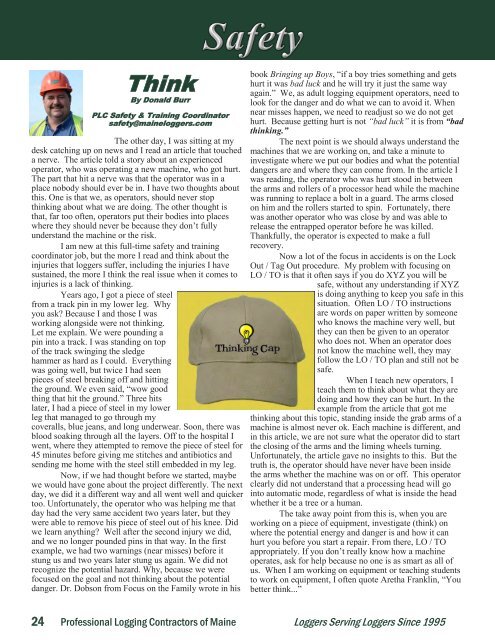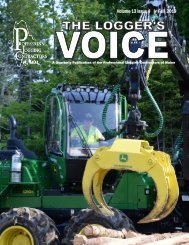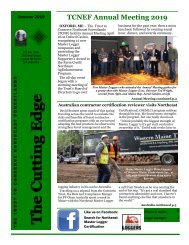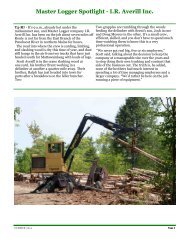PLC Logger's Voice Winter 2019
You also want an ePaper? Increase the reach of your titles
YUMPU automatically turns print PDFs into web optimized ePapers that Google loves.
Think<br />
By Donald Burr<br />
<strong>PLC</strong> Safety & Training Coordinator<br />
safety@maineloggers.com<br />
The other day, I was sitting at my<br />
desk catching up on news and I read an article that touched<br />
a nerve. The article told a story about an experienced<br />
operator, who was operating a new machine, who got hurt.<br />
The part that hit a nerve was that the operator was in a<br />
place nobody should ever be in. I have two thoughts about<br />
this. One is that we, as operators, should never stop<br />
thinking about what we are doing. The other thought is<br />
that, far too often, operators put their bodies into places<br />
where they should never be because they don’t fully<br />
understand the machine or the risk.<br />
I am new at this full-time safety and training<br />
coordinator job, but the more I read and think about the<br />
injuries that loggers suffer, including the injuries I have<br />
sustained, the more I think the real issue when it comes to<br />
injuries is a lack of thinking.<br />
Years ago, I got a piece of steel<br />
from a track pin in my lower leg. Why<br />
you ask? Because I and those I was<br />
working alongside were not thinking.<br />
Let me explain. We were pounding a<br />
pin into a track. I was standing on top<br />
of the track swinging the sledge<br />
hammer as hard as I could. Everything<br />
was going well, but twice I had seen<br />
pieces of steel breaking off and hitting<br />
the ground. We even said, “wow good<br />
thing that hit the ground.” Three hits<br />
later, I had a piece of steel in my lower<br />
leg that managed to go through my<br />
coveralls, blue jeans, and long underwear. Soon, there was<br />
blood soaking through all the layers. Off to the hospital I<br />
went, where they attempted to remove the piece of steel for<br />
45 minutes before giving me stitches and antibiotics and<br />
sending me home with the steel still embedded in my leg.<br />
Now, if we had thought before we started, maybe<br />
we would have gone about the project differently. The next<br />
day, we did it a different way and all went well and quicker<br />
too. Unfortunately, the operator who was helping me that<br />
day had the very same accident two years later, but they<br />
were able to remove his piece of steel out of his knee. Did<br />
we learn anything? Well after the second injury we did,<br />
and we no longer pounded pins in that way. In the first<br />
example, we had two warnings (near misses) before it<br />
stung us and two years later stung us again. We did not<br />
recognize the potential hazard. Why, because we were<br />
focused on the goal and not thinking about the potential<br />
danger. Dr. Dobson from Focus on the Family wrote in his<br />
book Bringing up Boys, “if a boy tries something and gets<br />
hurt it was bad luck and he will try it just the same way<br />
again.” We, as adult logging equipment operators, need to<br />
look for the danger and do what we can to avoid it. When<br />
near misses happen, we need to readjust so we do not get<br />
hurt. Because getting hurt is not “bad luck” it is from “bad<br />
thinking.”<br />
The next point is we should always understand the<br />
machines that we are working on, and take a minute to<br />
investigate where we put our bodies and what the potential<br />
dangers are and where they can come from. In the article I<br />
was reading, the operator who was hurt stood in between<br />
the arms and rollers of a processor head while the machine<br />
was running to replace a bolt in a guard. The arms closed<br />
on him and the rollers started to spin. Fortunately, there<br />
was another operator who was close by and was able to<br />
release the entrapped operator before he was killed.<br />
Thankfully, the operator is expected to make a full<br />
recovery.<br />
Now a lot of the focus in accidents is on the Lock<br />
Out / Tag Out procedure. My problem with focusing on<br />
LO / TO is that it often says if you do XYZ you will be<br />
safe, without any understanding if XYZ<br />
is doing anything to keep you safe in this<br />
situation. Often LO / TO instructions<br />
are words on paper written by someone<br />
who knows the machine very well, but<br />
they can then be given to an operator<br />
who does not. When an operator does<br />
not know the machine well, they may<br />
follow the LO / TO plan and still not be<br />
safe.<br />
When I teach new operators, I<br />
teach them to think about what they are<br />
doing and how they can be hurt. In the<br />
example from the article that got me<br />
thinking about this topic, standing inside the grab arms of a<br />
machine is almost never ok. Each machine is different, and<br />
in this article, we are not sure what the operator did to start<br />
the closing of the arms and the liming wheels turning.<br />
Unfortunately, the article gave no insights to this. But the<br />
truth is, the operator should have never have been inside<br />
the arms whether the machine was on or off. This operator<br />
clearly did not understand that a processing head will go<br />
into automatic mode, regardless of what is inside the head<br />
whether it be a tree or a human.<br />
The take away point from this is, when you are<br />
working on a piece of equipment, investigate (think) on<br />
where the potential energy and danger is and how it can<br />
hurt you before you start a repair. From there, LO / TO<br />
appropriately. If you don’t really know how a machine<br />
operates, ask for help because no one is as smart as all of<br />
us. When I am working on equipment or teaching students<br />
to work on equipment, I often quote Aretha Franklin, “You<br />
better think...”<br />
24 Professional Logging Contractors of Maine Loggers Serving Loggers Since 1995


















